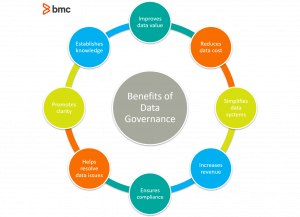If there’s anything that’s defining successful businesses today, it’s the successful understanding, use, and strategy of a company’s data. Understanding your data and determining how to implement it brings up a whole range of questions, from both users and stakeholders:
- How is the data stored?
- How do we know it’s timely and accurate?
- Can we trust it?
- What is the best data for my problem?
Answers to these questions aren’t easy, but a couple fields provide ways to organize and solve them: data management and data governance. Though these terms are often used interchangeably, they are entirely different programs. In this article, we’re clearing up any confusion about data management and data governance.
Data management: an IT practice
Let’s start with the more basic piece–data management. After all, if you don’t have solid data management in place, the rest of the data world is a beyond your reach. Data management is best seen as an IT practice with the goal of organizing and controling your data resources so that it is accessible, reliable, and timely whenever users call on it.
Viewed from this administrative perspective, the IT teams responsible for data management may rely on a comprehensive, customized collection of practices, theories, processes, and systems – an entire suite of tools – that collect, validate, store, organize, protect, process, and otherwise maintain data. After all, if data isn’t treated appropriately, the data can become corrupt or unusable, becoming completely useless.
Importantly, data management encompasses the entire lifecycle of a data asset, from the very initial creation of the data to the final retirement of the data. Data management can include many related fields and categories, including any of the following as relevant to your company:
- Data governance and data stewardship
- Data architecture
- Data quality management
- Data warehousing
- Business intelligence and analytics
- Metadata management
- Data security management
Data governance: a business strategy
If data management is the logistics of data, data governance is the strategy of data. Data governance should feel bigger and more holistic than data management because it is: as an important business program, governance requires policy, best reached by consensus across the company.
The purpose of data governance is to provide tangible answers to how a company can determine and prioritize the financial benefits of data while mitigating the business risks of poor data. Data governance requires determining what data can be used in what scenarios – which requires determining exactly what acceptable data is:
- What constitutes data?
- Where is it collected and used?
- How accurate must it be?
- Which rules must data follow?
- Who is involved in the various stages in a data lifecycle?
Importantly, data governance must go beyond IT and include stakeholders from across the enterprise. In order to ensure the safety, reliability, and trustworthiness of all data, governance requires that stakeholders from all business areas be involved. Consider the alternative: if each business silo approaches their data strategy differently, the end result is chaotic and not comprehensive enough to be useful.
Determining your data governance can include a wide range of processes, practices, and theories. It is likely to overlap with many data areas, like security, compliance, privacy, usability and integration. The end result may be some system that determines the decision rights and accountably of processes and individuals, like which data processes are used when, and which people can take certain actions under specific circumstances.
The ultimate goal is to determine a holistic way to control data assets, so that the company can get the absolute most value from the data.
Strategy, not technology
A good way to determine data governance? It is not defined by technology. Instead, technology should support data governance through automation, scaling, and augmentation. Data governance starts as a theory (or several), but your strategy can become tangible when you create:
- Data quality definitions, which determines the condition of the data, as well as its trustworthiness and adherence to data policies
- A business glossary, which records the meaning of all data, ensuring clarity and preventing unnecessary repetition
- Roles and responsibilities, which provides an organizational structure to who cares for and maintains which data
- Governed data catalogs, which serves to locate and facilitate understanding of the data. More advanced catalogs may even group data into various related collections, based on how previous users have accessed the data, which can provide additional meaning and insight and organization.
- Metadata creation, which links technical processes to specific data implementation, as well as anything that produces, uses, or influences data. This can even track the “lineage” of data, or the relationships of data across different sections, such as data within similar meanings, business processes data, and data specific to departments, business units, applications, other products, and even internal or external geographies.
Many experts in data governance also recommend a way for data systems to be organized to promote active participation from company employees, for instance. This may allow users to indicate when data is incorrect or fix it directly, which promotes both better-quality data but also trust that the data is strong and accurate.
Benefits of data governance
Once your data management processes are established, data governance is a logical next step because of the many benefits such guidance can provide, including:

- Increasing the value of your company’s data
- Decreasing costs within other subsets of data management, by knowing what you’ll focus on and what you’re choosing to skip
- Increasing enterprise revenue overall
- Standardizing data systems, policies, and procedures
- Ensuring correct regulation and compliance procedures
- Helping to solve issues with data
- Promoting transparency
- Establishing training and education around data
Data management and data governance are not the same things, in concept or in practice, but they are both essential to ensure the successful and valuable use of data in your company.
Additional resources
For related reading, explore these resources:







